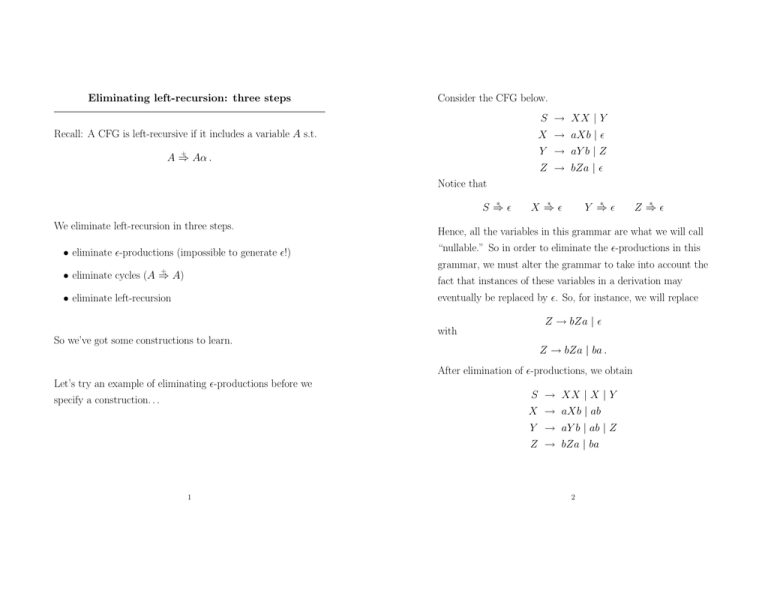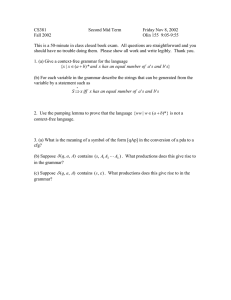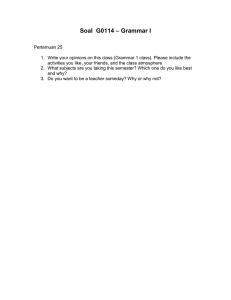Eliminating Left-Recursion in CFGs: A Compiler Design Guide
advertisement

Eliminating left-recursion: three steps
Consider the CFG below.
S → XX | Y
Recall: A CFG is left-recursive if it includes a variable A s.t.
X → aXb | ǫ
Y → aY b | Z
+
A⇒
Aα .
Z → bZa | ǫ
Notice that
∗
S⇒
ǫ
We eliminate left-recursion in three steps.
• eliminate ǫ-productions (impossible to generate ǫ!)
∗
X⇒
ǫ
∗
Y ⇒
ǫ
∗
Z⇒
ǫ
Hence, all the variables in this grammar are what we will call
“nullable.” So in order to eliminate the ǫ-productions in this
grammar, we must alter the grammar to take into account the
+
• eliminate cycles (A ⇒
A)
fact that instances of these variables in a derivation may
eventually be replaced by ǫ. So, for instance, we will replace
• eliminate left-recursion
So we’ve got some constructions to learn.
with
Z → bZa | ǫ
Z → bZa | ba .
After elimination of ǫ-productions, we obtain
Let’s try an example of eliminating ǫ-productions before we
S → XX | X | Y
specify a construction. . .
X → aXb | ab
Y → aY b | ab | Z
Z → bZa | ba
1
2
Eliminating ǫ-productions
Given a CFG G = (V, Σ, S, P ), a variable A ∈ V is nullable if
∗
A⇒
ǫ.
∗
A is nullable if A ⇒
ǫ.
Pǫ is the set of all productions
A→β
s.t. A 6= β, β 6= ǫ, and P includes a production
The main step in the ǫ-production elimination algorithm then
is that the set P of productions is replaced with the set Pǫ of
A→α
s.t. β can be obtained from α by deleting zero or more
all productions
A→β
s.t. A 6= β, β 6= ǫ, and P includes a production
occurrences of nullable variables.
Example Let’s apply ǫ-production elimination to
A→α
S → XZ
s.t. β can be obtained from α by deleting zero or more
X → aXb | ǫ
occurrences of nullable variables.
Z → aZ | ZX | ǫ
Example Applying ǫ-production elimination to the CFG
G = ({S}, {a, b}, S, { S → aSb | ǫ })
What are the nullable variables?
What are the new productions?
yields the CFG
Gǫ = ({S}, {a, b}, S, { S → aSb | ab }) .
3
4
Eliminating ǫ-productions can greatly increase the size of a
Eliminating cycles
grammar.
Example Eliminating ǫ-productions from
A grammar has a cycle if there is a variable A s.t.
+
A⇒
A.
S → A1A2 · · · An
A1 → ǫ
We’ll call such variables cyclic.
A2 → ǫ
...
If a grammar has no ǫ-productions, then all cycles can be
An → ǫ
eliminated from G without affecting the language generated,
using a construction we will specify in a moment.
increases the number of productions from n + 1 to 2n − 1.
Let’s try an example first. Consider the grammar with
productions
S → X | Xb | SS
What about ambiguity?
X → S|a
Claim If G is unambiguous, so is Gǫ .
+
+
We have S ⇒
S and X ⇒
X.
We can eliminate occurrences of cyclic variables as rhs’s of
productions, thus eliminating cycles.
S → a | Xb | SS
X → Xb | SS | a
5
6
Given a CFG G = (V, Σ, S, P ), the main step in the cycle
Replace the set P of productions with the set Pc of
elimination algorithm is to replace the set P of productions
productions obtained from P by replacing
with the set Pc of productions obtained from P by replacing
• each production A → B where B is cyclic
• with new productions A → α s.t. α is not a cyclic variable
• each production A → B where B is cyclic
• with new productions A → α s.t. α is not a cyclic variable
∗
and there is a production C → α s.t. B ⇒
C.
∗
and there is a production C → α s.t. B ⇒
C.
The resulting CFG is Gc = (V, Σ, S, Pc).
Let’s consider an example illustrating the importance of
requiring that there be no ǫ-productions.
S → a | SS | ǫ
Note: You can probably convince yourself that Pc has no
cycles, and that Gc generates the same languages as G.
Notice that S is a cyclic variable, since
Let’s try the construction. . .
S ⇒ SS ⇒ S .
S → X | Xb | Y a
X → Y |b
But S never appears as the rhs of a production, so the
Y → X|a
construction does nothing.
Which variables are cyclic?
Which productions will be replaced?
(BTW What does the ǫ-elimination algorithm do to this
grammar?)
With what?
7
8
Eliminating “immediate” left recursion
If
A → Aα1 | Aα2 | · · · | Aαm | β1 | β2| · · · | βn
Let’s begin with an easy example, already considered:
A → Ab | b
represents all the A-productions of the grammar, and no βi
begins with A, then we can replace these A-productions by
A → β1A′ | β2 A′| · · · | βnA′
A′ → α1A′ | α2 A′ | · · · | αm A′ | ǫ
This grammar is left-recursive, since
+
A⇒
Ab .
If our grammar has S-productions
In this case, we can eliminate left recursion as follows:
A → bA′
S → SX | SSb | XS | a
we can replace them with
S → XSS ′ | aS ′
A′ → bA′ | ǫ
S ′ → XS ′ | SbS ′ | ǫ
More generally, we can eliminate “immediate” left recursion as
Notice that this construction can fail to eliminate
follows. If
left-recursion if we have the production
A → Aα1 | Aα2 | · · · | Aαm | β1 | β2| · · · | βn
represents all the A-productions of the grammar, and no βi
A→A!
For instance,
begins with A, then we can replace these A-productions by
A → β1A′ | β2 A′| · · · | βnA′
A′ → α1A′ | α2 A′ | · · · | αm A′ | ǫ
9
A → A | Ab | b
becomes
A → bA′
A′ → A′ | bA′ | ǫ
10
If
If
A → Aα1 | Aα2 | · · · | Aαm | β1 | β2| · · · | βn
A → Aα1 | Aα2 | · · · | Aαm | β1 | β2| · · · | βn
represents all the A-productions of the grammar, and no βi
represents all the A-productions of the grammar, and no βi
begins with A, then we can replace these A-productions by
begins with A, then we can replace these A-productions by
A → β1A′ | β2 A′| · · · | βnA′
A → β1A′ | β2 A′| · · · | βnA′
A′ → α1A′ | α2 A′ | · · · | αm A′ | ǫ
A′ → α1A′ | α2 A′ | · · · | αm A′ | ǫ
Another interesting special case. What if there are no βi’s?
Notice also that this construction works only “locally”:
For example,
That is, indirect recursion is not eliminated.
A → AA | Ab .
For example, if we apply this construction to both variables in
Then everything that can be derived from A has a variable in
S → SX | SSb | XS | a
it, so A cannot appear in a derivation of a sentence.
X → Sa | Xb
we obtain
And the construction handles this in an interesting way,
S → XSS ′ | aS ′
yielding
S ′ → XS ′ | SbS ′ | ǫ
′
′
′
A → AA | bA | ǫ
X → SaX ′
X ′ → bX ′ | ǫ
but no A-productions.
+
and so have S ⇒
SaX ′ SS ′ , for instance.
11
12
Here’s an algorithm that eliminates all left-recursion for any
CFG without ǫ-productions and without cycles.
Arrange the variables in some order A1 , A2, . . . , An .
for i := 1 to n do begin
for j := 1 to i − 1 do begin
replace each production of the form Ai → Aj γ
by the productions Ai → δ1 γ | δ2 γ | · · · | δk γ
where Aj → δ1 | δ2 | · · · | δk are all the current Aj -productions;
end
Arrange the variables in some order A1 , A2, . . . , An .
for i := 1 to n do begin
for j := 1 to i − 1 do begin
replace each production of the form Ai → Aj γ
by the productions Ai → δ1 γ | δ2 γ | · · · | δk γ
where Aj → δ1 | δ2 | · · · | δk are all the current Aj -productions;
end
eliminate the immediate left recursion among the Ai -productions;
end
So at this point we have grammar
eliminate the immediate left recursion among the Ai -productions;
end
S → XSS ′ | aS ′
S ′ → XS ′ | SbS ′ | ǫ
X → Xb | Sa | b
Consider the grammar
S → SX | SSb | XS | a
and the next obligation is to replace the production
X → Xb | Sa | b
X → Sa
Let’s order the variables S, X:
with the productions
The first time through we simply eliminate immediate left
X → XSS ′ a | aS ′ a .
recursion in S-productions, yielding
S → XSS ′ | aS ′
S ′ → XS ′ | SbS ′ | ǫ
We then eliminate immediate left recursion among
X → XSS ′ a | aS ′ a | Xb | b .
X → Xb | Sa | b
13
14
Eliminating immediate left recursion among
X → XSS ′ a | Xb | b | aS ′ a
Let’s look at examples showing that this algorithm can fail if
the grammar has ǫ-productions or cycles.
In the simplest case, when there is only one variable, call it X,
yields
X → bX ′ | aS ′ aX ′
X ′ → SS ′ aX ′ | bX ′ | ǫ
So the final result is
S → XSS ′ | aS ′
′
′
X → bX | aS aX
X →X.
reduces to elimination of immediate left recursion among
′
′
production
Moreover, the whole left recursion elimination algorithm
S → XS | SbS | ǫ
′
the presence of a cycle implies that the grammar includes the
X-productions.
′
X ′ → SS ′ aX ′ | bX ′ | ǫ
And we have previously observed that our construction for
immediate left recursion elimination is no good in the presence
of X → X.
For example, if the grammar is
X→X |a
the construction for eliminating immediate left recursion yields
X → aX ′
X′ → X′
What about more complex cycles?
15
16
S → X|b
Here’s an example with an ǫ-production and no cycles:
X → S|a
S → XSa | b
X → ǫ
Try ordering S, X.
First step: eliminate immediate left recursion in
Try order S, X.
S-productions.
First step: eliminate immediate left recursion in
There is none.
S-productions.
Next: replace production
There is none.
X→S
with productions
Next: replace any X-productions whose rhs begins with S.
There are none.
X → X | b.
Last: eliminate immediate left recursion in the current
It remains only to eliminate immediate left recursion in the
current X-productions, which are
X-productions.
There is none.
X → X | b | a.
So our left-recursion elimination algorithm leaves the grammar
As before, the presence of production X → X breaks our
construction — which yields
unchanged.
+
Yet S ⇒
Sa, so the grammar is left-recursive.
X → bX ′ | aX ′
X′ → X′
17
18
So now we can take any grammar and eliminate left-recursion
For next time
(in three steps), making it suitable for top-down parsing (with
backtracking!).
Read 4.4.
Notice that this works even for ambiguous grammars.
Next time we’ll define the main component of a top-down
parser — the parsing table.
But practically speaking, we would also like to avoid
backtracking.
Next time we’ll see how this can be done for top-down parsing.
We’ll define the class of LL(1) grammars, suitable for
predictive parsing.
19
20


